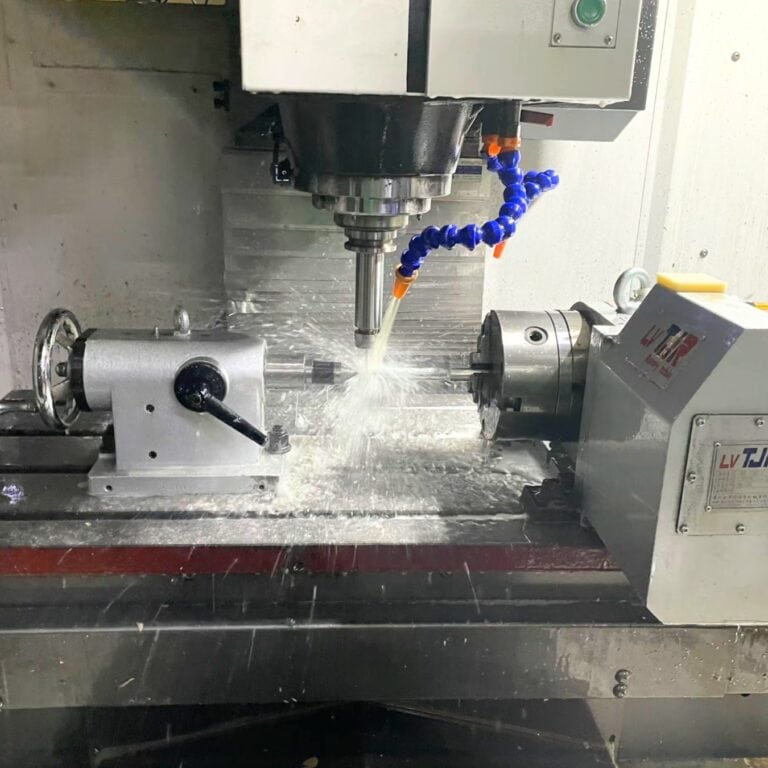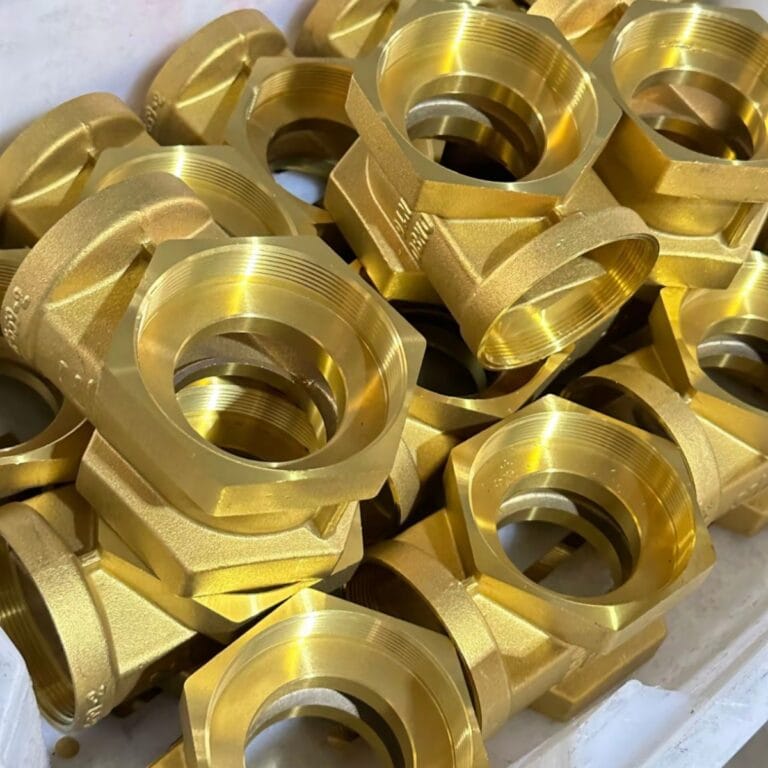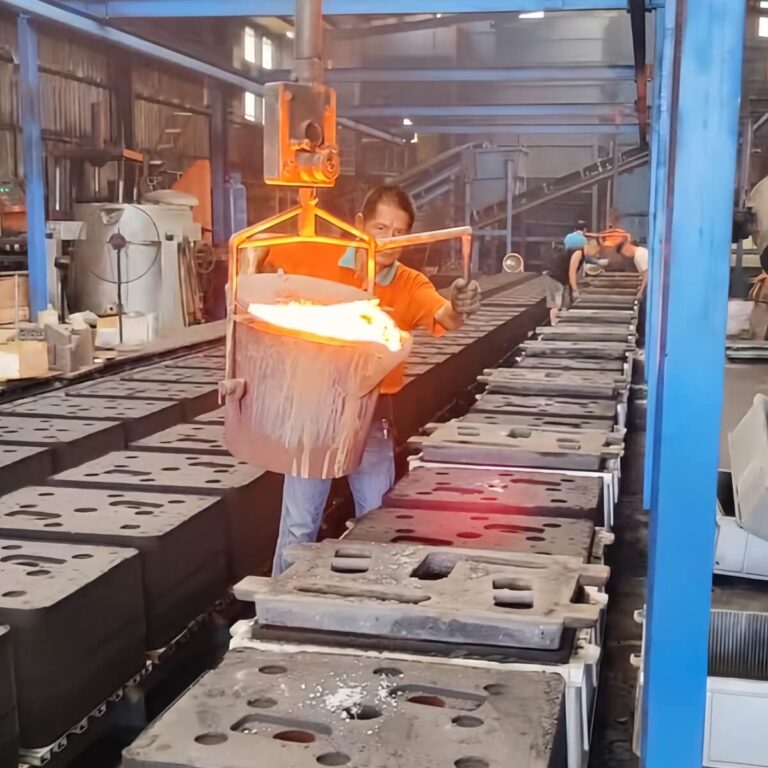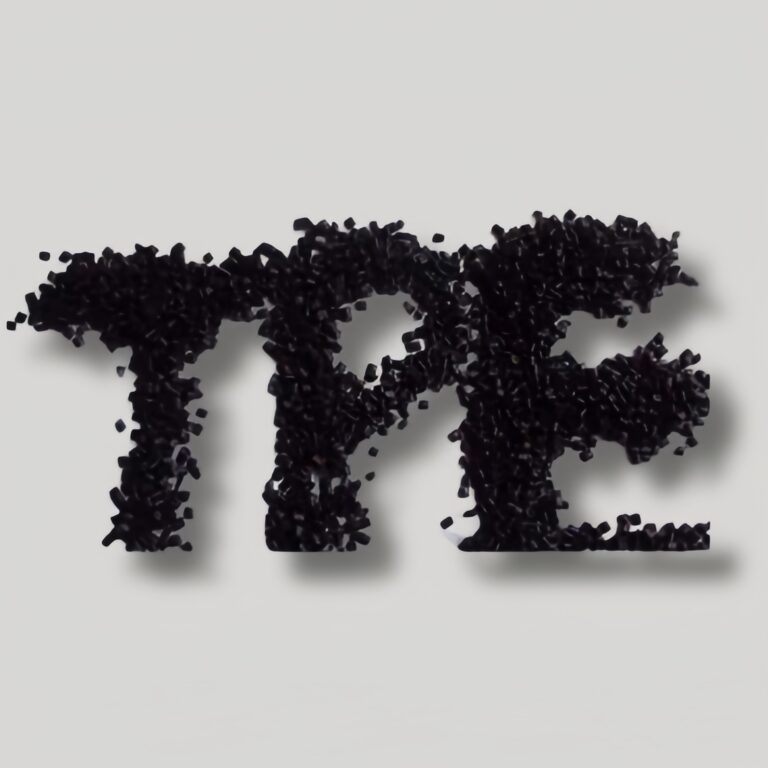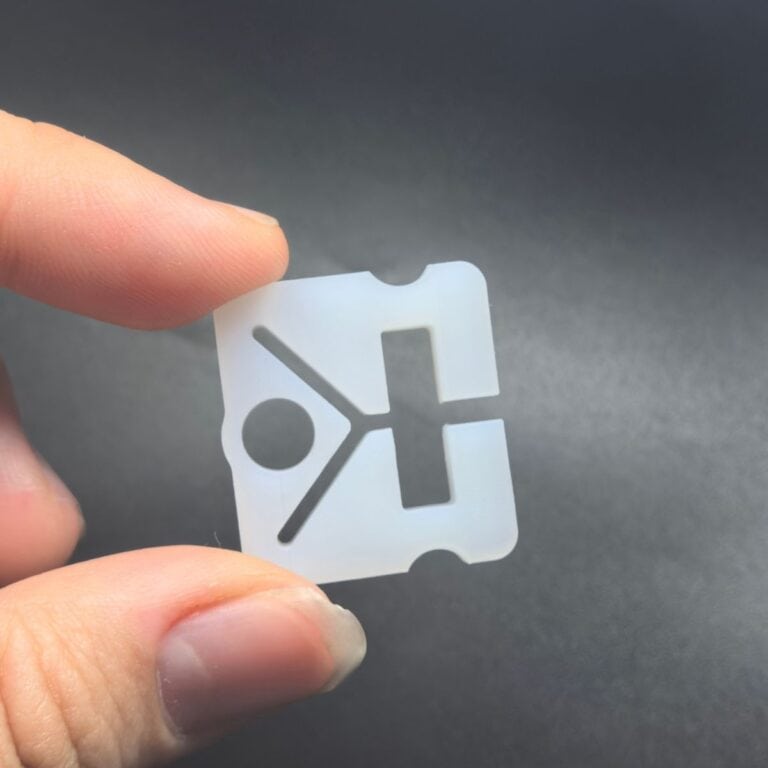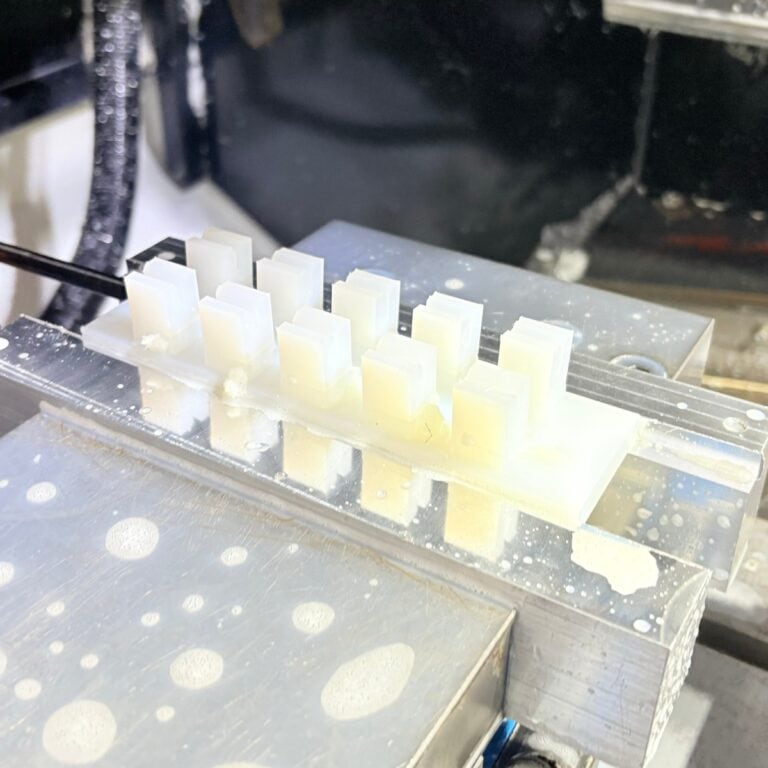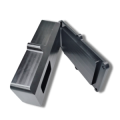A rivet is a fastener used to join two or more parts securely. Parts fixed with rivets have good plasticity, toughness, and integrity, and the riveted joints are not easily deformed.
Rivets are suitable for a wide range of materials. Commonly used materials include aluminum, iron, copper, and especially stainless steel rivets, which have strong corrosion resistance and better metal fatigue properties. The riveted parts are easy to disassemble, making them very convenient for inspection and maintenance.
They are a good choice for large structures or directly bearing power.
This blog will help you understand rivet types and working principles, how to remove rivets, and their application fields.
What Are the Rivets
Rivets are special metal fasteners that require a rivet gun to complete the entire riveting process. It has the characteristics of good toughness and plasticity, high precision, beautiful appearance after linking, simplicity, convenience, strong stability, reliability, environmental protection, and low cost.
In addition to common standard models, different types of fasteners can be customized for various industries. Pins are used in heavy industry and widely used in consumer goods, such as luggage, bags, shoes, household items, etc.
Rivets are divided into two types: cold riveting and hot riveting. Cold riveting means that the rivets are operated at average temperatures. It is suitable for steel and aluminum alloy riveting with a diameter of less than 10mm.
11 Types of Rivets & How Does Rivet Work
1. Blind Rivets
The blind rivet is a very common metal rivet. It consists of a shell and an inner core rod. It can fix both small and large objects.
The working principle of blind rivets is that when the rivet is placed on the object to be fixed, the shell will be compressed, so the core rod is also compressed, making the core rod unable to move. When the wrench is placed on the rivet, the housing and core rod will be loosened, allowing the rivet to be easily removed.
The specifications of core blind rivets include open-core blind rivets, closed-core blind rivets, drum-type core blind rivets, brushed rivets, seahorse nails, and lantern rivets.
Commonly used blind rivets are made of aluminum & carbon steel, with the nail body made of aluminum and the nail core made of carbon steel.
2. Solid Rivets
A solid rivet is a fastener made of metal. It includes a nail head, a rivet body, and a rivet tail. The head of a solid buckle is usually round or disc-shaped, and the tail is a long, slender pole that fits into a pre-drilled hole.
The working principle of solid rivets is to use the head of the rivet to link two or more thin plates together to form a strong structure. During the riveting process, the rivets will be placed between the connected plates and then riveted. A gun or hammer applies pressure to deform the heads of the rivets and secure them to the sheet, creating the link.
The types of solid rivets include flat-head solid rivets, pointed-head solid rivets, excess-length rivets (POP rivets), structural blind rivets, tubular rivets, aluminum-core rivets, large-brim solid rivets, small-brim solid rivets, etc.
Steel, copper, and stainless steel are used as solid rivet materials. Solid rivets are mainly used in automobiles, electronics, electrical appliances, aircraft, and other fields.
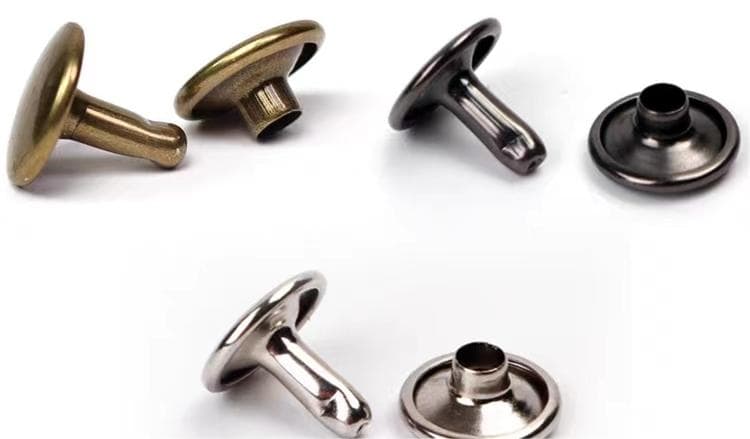
3. Hollow Rivets
A hollow rivet is a nail-like fastener and the most primitive type of rivet. It connects two parts with a through hole and a cap at one end. When joining, the riveted parts are linked by self-deformation or interference. This kind of rivet is based on a semi-hollow rivet and is processed hollow to the head. It has the characteristics of being lightweight and having a weak nail head.
The working principle of hollow rivets is to insert the rivet body between the two objects to be connected and then use a rivet gun at one end of the rivet body to press the rivet cap into the rivet body, allowing it to expand and be fixed to the object.
When the rivet expands, and the part is squeezed, a strong clamping force is generated to connect the two things firmly.
There are four types of rivets: hollow rivets, structural hollow rivets, closed hollow rivets, and semi-hollow rivets.
The materials of hollow rivets are mainly stainless steel, aluminum alloy, titanium alloy, and copper. They are primarily used in light equipment, electronic products, and other industries.
4. Semi-hollow Rivets
Semi-hollow rivets are rivets with a hollow shaft body. They need to be riveted using a rivet gun or special tools. The semi-hollow rivets will be extruded and deformed during the riveting process, forming a tight combination with the connecting material. This combination has many advantages—high intensity.
The principle of semi-hollow rivets is to utilize the unique structure of the nail core and nail body to achieve tight integration with the connecting material through extrusion deformation during installation. The nail core of semi-hollow rivets is relatively thin.
The middle part of the nail body is a solid structure, and the tail is a hollow structure.
During installation, use a rivet gun or unique tool to press the nail core down to pass through the upper connecting material and squeeze the tail. The hollow portion forms an opening to secure the connecting material.
The types of semi-hollow rivets include semi-round head hollow rivets, countersunk head semi-hollow rivets, large flat round head semi-hollow rivets, flat cone head semi-hollow rivets, and fish-eye head semi-hollow rivets, among others.
The materials of semi-hollow rivets are mainly aluminum alloy, copper alloy, and stainless steel. They are primarily used in construction, electrical appliances, aviation, and other fields.
5. R Type Plastic Rivets
R-type plastic rivets, also known as expansion rivets, comprise plastic sub-nails and female buckles. They are mainly used to connect plastic and other lightweight materials.
The working principle of R-type plastic rivets is to use plastic deformation and mechanical locks to connect. During installation, insert the rivet’s sub-nails into the holes of the female buckles. The feet of the sub-nails will expand under the force, opening the specially designed feet.
Lock firmly into the cavity of the female fastener, thereby tightly connecting the two connecting pieces.
R-type plastic rivets include ordinary R-type plastic rivets, double-tube R-type plastic rivets, detachable R-type plastic rivets, quick-installation R-type plastic rivets, etc.
The material of R-type plastic rivets is usually nylon 6 (imported American DuPont nylon material). R-type plastic buckles are mainly used for lightweight materials such as insulation and circuit boards.
6. Flush Rivets
Flush rivets are standard solid connectors consisting of a rivet body and a rivet cap. Their main feature is that the head is flat and round, with a neck at the bottom for connecting materials.
The working principle of flathead and flathead rivets is to use metal’s plastic deformation to expand the rivet head and fill the metal hole, thereby firmly connecting two parts.
Types of flush include,
- Large flush rivets
- Semi-round-flush rivets
- Flat cone-flush rivets
- Tubular rivets
- Semi-hollow rivets
- Countersunk flush rivets
- Flat-flush rivets
Flat head and flat round head rivets are usually made of aluminum alloy and steel. Flathead and flat round head rivets are mainly used in electronic products.
7. Fan Rivets
Fan rivets usually have a flat head and an elongated stem. The head is used to fix the radiator, and the branch passes through the fan blades, where it is hammered and tightened.
The working principle of fan rivets is to use the mechanical and physical properties of the rivets to tightly connect the fan blades and the radiator to enhance the heat dissipation effect.
Specifically, the head of the fan rivet is flat to better adapt to the shape of the fan blade, while the stem is more prolonged and can easily pass through the fan blade and be hammered and tightened.
During installation, the user only needs to pass the rivet stem through the fan blade and then use a rivet gun or hammer to tap and tighten the rivet head to secure it to the radiator.
Fan rivets are special rivets explicitly designed for fans. Commonly used fan rivets are made of aluminum alloy & steel.
8. Core Rivets
The core strike rivet is unilateral. The head is usually an oblate head or a countersunk head. The body is exposed, and the end of the nail head is flush, which is a very convenient riveting fastener.
The working principle of the core-hit rivet is that when the nail core is struck, the metal sheet between the nail core’s head and body is stretched, causing the nail body to be tested and expanded, tightly fitting the connected hole wall. This forms strong links.
Core strike rivets include,
- Oblate head core strike rivets
- Inverted tooth plastic rivets
- All-aluminum core strike rivets
- Aluminum-steel core strike rivets
- Stainless steel core strike rivets
The material of core rivets is aluminum, steel, and stainless steel. Core rivets are mainly used in electronic products and other fields.
9. Tree Rivets
Tree-shaped rivets are plastic rivets, also known as Christmas tree-shaped rivets. They have a toothed sheet structure and good elasticity.
The tree-shaped rivet’s working principle is based on its inverted tooth-shaped design. When pressed on the mounting surface, the inverted teeth expand and firmly grasp it, thereby achieving the fixation between two or more materials.
The rivets have good elasticity and recovery properties and can be installed manually by pressing directly through the round holes.
Types of tree rivets include solid tree rivets, hollow tree rivets, plastic tree rivets, etc.
The master tree rivets are usually made of polyamide (nylon) and polycarbonate (PC). In addition, aluminum alloys are used. Tree ri are also used, and vets are mainly used in industrial fields.
10.Countersunk Head Rivets
Countersunk head rivets are metal fasteners that use their deformation to connect riveted parts. The characteristic is that the screw heads are all sunk into the connecting elements. They are usually composed of rivets, rivet shanks, and countersunk heads.
Countersunk rivets compile the countersunk portion to secure the nail to the material’s surface, creating a solid connection. During the installation process, the countersunk head rivet needs to be inserted into the sinking space of the connector.
Then, the rivet head and the countersunk head part are compressed together by tapping or a compression tool so that the blunt part of the nail is in close contact with the surface to be connected, and the countersunk head part is pressed tightly.
The disc-shaped structure of the head part can also fill the countersunk hole to ensure that the nail is more stably tightened on the connected space.
Countersunk head rivets include round head countersunk head rivets, flat head countersunk head rivets, semi-round head countersunk head rivets, stainless steel countersunk head rivets, aluminum countersunk head rivets, and carbon steel countersunk head rivets, etc.
The material of countersunk head rivets is usually aluminum, steel, or stainless steel. Countersunk rivets are mainly used in decoration, electrical appliances, automobiles, and other fields.
11. Ring Groove Rivets
Ring groove rivets, also known as large-diameter ring groove rivets, are a particular type of metal rivet characterized by a ring groove structure. They are mainly composed of a nail body, a small head, and a large head. The small head is the nail.
The raised part is on one end of the body, and the big head is the flat part on the other end of the rivet.
The working principle of ring groove rivets is to insert the rivet into two materials that need to be connected, then form an annular groove on one end of the clip, and finally expand the other end of the clip and tightly connect it with the annular groove by hammering or other methods.
For the link, the length of the rivets will also be increased, which can increase the strength and stability of the connection.
The types of ring groove rivets,
- Sided blind pull rivets
- Single-sided blind pull rivets
- Brushed core blind rivets
- Hackerbohm rivets
- Large diameter ring groove rivets
- Small diameter ring groove rivets
- Continuous groove ring groove rivets
- Short tail rivets
The material of ring groove rivets is carbon steel, stainless steel, or aluminum alloy. Ring groove rivets are mainly used in vehicles, construction, etc.

6 Common Types of Rivets Industry
1.New Energy Electric Vehicles
Rivets are an indispensable fastening part of the automotive industry, especially in the new energy field, which is currently the most active market. Riveting is mechanical engineers’ most popular assembly method for car center consoles, battery packs, frames, battery boxes, body panels, etc.
Different requirements call for different material types, commonly used aluminum and stainless steel. This rivet type has tensile and anti-loss properties and meets high-strength practical occasions.
2.Aerospace
The aerospace field has high mechanical performance requirements for all assembly parts, and rivets are important. Compared with welding technology, riveting is more suitable for assembling oversized pieces.
In the entire manufacturing of flight equipment, riveting is the most commonly used process in aircraft manufacturing. An airplane uses up to a million rivets.
3.Communications Industry
The communication industry is the infrastructure composed of network information. Communication equipment manufacturing, including routers, switches, modems, and other equipment, is crucial to communication transmission. The application of plastic rivets in this industry is relatively standard.
They are used to assemble 5G communication equipment and parts, such as communication panels, communication sheet metal manufacturing, communication cabinets, mobile phone case brackets, and 5G communication station equipment.
4.Ship Manufacture
Rivets are an essential part of ship manufacturing. Hot riveting and pressure riveting are commonly used. Materials include steel, stainless steel, titanium alloy, and aluminum-magnesium alloy. Hull riveting has many benefits. It can connect two thicker metal plates. The riveted hull can withstand more pressure, has higher connection strength, and adapt to harsh environments.
5.Instrumentation
Riveting is used in various instrumentation products, and product parts require high precision. Semi-automatic and fully automatic riveting are commonly used. The cost of riveting is competitive, the service life is longer, and the performance of riveted parts is stable. Application products include pressure gauges, dials, testing instruments, and automotive instruments.
6.Household Products
Commonly used in home furnishings are blind rivets and core strike rivets; the materials are copper and stainless steel. There are several benefits of using rivets instead of screws. They will not loosen after long-term use, and the riveted household items will be stable.
Used in various products: doors and windows, folding chairs, knife handles, clothes drying racks, strollers, wardrobes, fans, household appliances, and sofas.
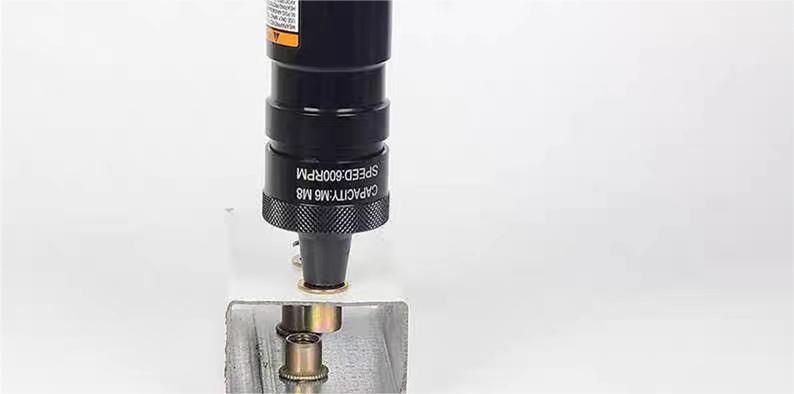
FAQs
1.What is the difference between a rivet machine and a rivet gun?
The most straightforward difference is that the rivet gun can be operated with one hand and is generally used for small workloads. The rivet machine is a large piece of equipment and is only used when there are many tasks and high demand.
2.Are the rivets loose?
Rivets may become loose, usually caused by improper operation during installation. If an external force affects it, check whether the rivet is damaged. If damage occurs, replace the pin.
3.How much heat can rivets withstand?
Typically, rivets can withstand temperatures of around 300 degrees Celsius, but if the coating can withstand higher temperatures, the rivets’ ability to withstand will also increase.
4.Are rivets expensive?
The cost of rivets is related to the type of rivet and the materials used. Stainless steel and aluminum rivets will be relatively expensive, while steel (iron) rivets will be relatively cheap. R-type and tree-shaped rivets with a unique structure will also be more expensive.
Conclusion
There are many types of rivets. Selecting the appropriate rivet type and riveting method is critical to the mechanical properties of the final assembled part. Rivets are used in sheet metal fabrication and are very popular in CNC machining manufacturing.
Tirapid can help you choose a rivet and riveting method for your product based on your needs. They can meet the highest requirements and standards, whether it is appearance or performance requirements.

